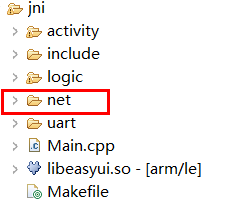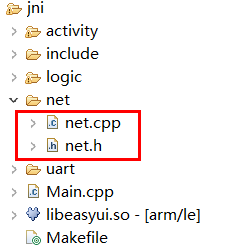Socket programming
만약 Linux socket programming에 익숙한 개발자라면 standard Linux socket programming interface에 따라 네트워크 프로그래밍을 할 수 있습니다. 우리는 TCP 클라이언트를 구축하기 위해 일반적으로 사용되는 소켓 프로그래밍 구현 작업에 사용하기 편리한 Linux의 표준 인터페이스를 기반으로 간단한 패키지를 만들었습니다. 필요한 경우 아래 단계에 따라 소스 코드를 프로젝트에 통합 할 수 있습니다.
Porting steps
사용법
TCP Client
- 필요한 헤더 파일
#include "net/net.h" - 예제
//Use TCP protocol to connect to port 80 of the domain name www.baidu.com, and change the domain name to IP. net::Conn* conn = net::Dial("tcp", "www.baidu.com:80"); //net::Conn* conn = net::Dial("tcp", "14.215.177.38:80"); if (conn) { byte buf[2048] = {0}; const char* req = "GET / HTTP/1.1\r\nConnection: close\r\n\r\n"; //send conn->Write((byte*)req, strlen(req)); while (true) { //read,1000ms timeout int n = conn->Read(buf, sizeof(buf) - 1, 1000); if (n > 0) { buf[n] = 0; LOGD("read %d bytes: %s", n, buf); } else if (n == 0) { LOGD("Normal disconnection"); break; } else if (n == net::E_TIMEOUT) { LOGD("read timeout"); } else { LOGD("error"); break; } } //Close the connection conn->Close(); //Release memory delete conn; conn = NULL;
UDP Client
- 필요한 헤더 파일
#include "net/net.h" - 예제
//Use udp protocol to connect IP: 192.168.1.100 port 8080 net::Conn* conn = net::Dial("udp", "192.168.1.100:8080"); if (conn) { byte buf[2048] = {0}; const char* req = "hello"; conn->Write((byte*)req, strlen(req)); while (true) { //read,1000ms timeout int n = conn->Read(buf, sizeof(buf) - 1, 1000); if (n > 0) { buf[n] = 0; LOGD("read %d bytes: %s", n, buf); } else if (n == 0) { LOGD("Normal disconnection"); break; } else if (n == net::E_TIMEOUT) { LOGD("read timeout"); //Set timeout here to exit break; } else { LOGD("error"); break; } } //Close the connection conn->Close(); //Release memory delete conn; conn = NULL; }

